PBS News: November 26 – December 1, 2019, How innovation and small steps can help us solve The Plastic Problem, and Largest slave revolt in U.S. history lives on in reenactment,
The California Sunday Magazine: 3 kids. 2 paychecks. No home.
TED Talks: Cathy Mulzer – The incredible chemistry powering your smart phone? and Kim Preshoff – What’s a smartphone madeof#t-286167
Lily R. : 500 + Fish Identification Documentary by Pano4life
Digital Photography School: How to Get Super Sharp Landscape Photography Images
Thisiscolossal: 120,000 Ribbons Wave Across the Former Footprint of the Berlin Wall in an Installation Marking 30 Years Since the Peaceful Revolution
Ing Peace Project: 6th Annual Art and Music Fair, Elwood Park 1
PBS NewsHour Weekend full episode December 1, 2019
Dec 1, 2019 PBS NewsHour
On this edition for Sunday, December 1, severe weather disrupts holiday travel across the U.S., and on World AIDS Day, how inequality impacts those living with HIV. Also, how Mac DeMarco is harnessing the internet to thrive as an indie artist. Alison Stewart anchors from New York. Stream your PBS favorites with the PBS app: https://to.pbs.org/2Jb8twG Find more from PBS NewsHour at https://www.pbs.org/newshour Subscribe to our YouTube channel: https://bit.ly/2HfsCD6
PBS NewsHour Weekend full episode November 30, 2019
Nov 30, 2019 PBS NewsHour
On this edition for Saturday, November 30, the latest on the London Bridge attack, Illinois schools placed thousands of children in isolation rooms, and New York’s Mohawk tribe and their fight to restore their endangered language. Alison Stewart anchors from New York. Stream your PBS favorites with the PBS app: https://to.pbs.org/2Jb8twG Find more from PBS NewsHour at https://www.pbs.org/newshour Subscribe to our YouTube channel: https://bit.ly/2HfsCD6
PBS NewsHour full episode November 29, 2019
Nov 29, 2019 PBS NewsHour
Friday on the NewsHour, the prime minister of Iraq announces his resignation after weeks of protests that have left hundreds dead. Plus: What Afghan women stand to lose if the Taliban return to power, questions about a fatal accident at an Amazon warehouse, turning food waste into electricity, analyzing the week’s political news with Shields and Brooks and a preview of the new film “The Report.” WATCH TODAY’S SEGMENTS: After months of deadly protest, Iraq’s government in chaos https://www.youtube.com/watch?v=fMWKJ… News Wrap: Stabbing attacks jolt London, the Netherlands https://www.youtube.com/watch?v=HuYGx… What peace talks with the Taliban mean for Afghan women https://www.youtube.com/watch?v=hu_9I… Fatality at Amazon warehouse raises questions about safety https://www.youtube.com/watch?v=SU0v2… How these farmers are turning manure and food waste to power https://www.youtube.com/watch?v=bmX1s… Shields and Brooks on impeachment politics, 2020 Democrats https://www.youtube.com/watch?v=l_fYq… What ‘The Report’ says about the CIA and post-9/11 torture https://www.youtube.com/watch?v=KCo1t… Stream your PBS favorites with the PBS app: https://to.pbs.org/2Jb8twG Find more from PBS NewsHour at https://www.pbs.org/newshour Subscribe to our YouTube channel: https://bit.ly/2HfsCD6 Follow us: Facebook: https://www.pbs.org/newshour Twitter: https://www.twitter.com/newshour Instagram: https://www.instagram.com/newshour Snapchat: @pbsnews Subscribe: PBS NewsHour podcasts: https://www.pbs.org/newshour/podcasts Newsletters: https://www.pbs.org/newshour/subscribe
PBS NewsHour full episode November 28, 2019
Nov 28, 2019 PBS NewsHour
Thursday on the NewsHour, President Trump made a Thanksgiving trip to Afghanistan, where he served troops a holiday dinner and met with Afghan President Ashraf Ghani. Plus: The history of impeachment in America, how to reduce food waste, a crackdown on protests in Iran, the outlook for long-haul truckers and former students of viral sensation Flossie Lewis express their thanks to her. WATCH TODAY’S SEGMENTS: In Afghanistan, Trump says Taliban talks have restarted https://www.youtube.com/watch?v=bv2j-… News Wrap: Dozens more protesters killed in Iraqi violence https://www.youtube.com/watch?v=Qjwrr… A look back at presidential impeachment in U.S. history https://www.youtube.com/watch?v=g2pRV… How Americans can change their mindset about wasting food https://www.youtube.com/watch?v=zxl0u… Behind the protests and brutal government crackdown in Iran https://www.youtube.com/watch?v=xOhYJ… Stream your PBS favorites with the PBS app: https://to.pbs.org/2Jb8twG Find more from PBS NewsHour at https://www.pbs.org/newshour Subscribe to our YouTube channel: https://bit.ly/2HfsCD6
PBS NewsHour full episode November 27, 2019
Nov 27, 2019 PBS NewsHour
Wednesday on the NewsHour, another set of revelations in the inquiry into President Trump’s Ukraine dealings. Plus: How Americans across the country feel about impeachment, shipping speed vs. employee safety at Amazon warehouses, how food growers are striving to reduce wasted product, rising sea levels threaten a small Alaskan town and actress Adrienne C. Moore on her life’s characters. WATCH TODAY’S SEGMENTS: News Wrap: Major storms disrupt Thanksgiving travel https://www.youtube.com/watch?v=yYvlz… What were Rudy Giuliani’s business dealings in Ukraine? https://www.youtube.com/watch?v=-YAME… What voters across America are saying about impeachment https://www.youtube.com/watch?v=0JjSt… An inside look at injury rates in Amazon warehouses https://www.youtube.com/watch?v=dce_A… How California is fighting the problem of food waste https://www.youtube.com/watch?v=uFmot… As water levels rise, an Alaska town flees to higher ground https://www.youtube.com/watch?v=2vMZs… Actress Adrienne C. Moore on owning her characters https://www.youtube.com/watch?v=CAfei… Stream your PBS favorites with the PBS app: https://to.pbs.org/2Jb8twG Find more from PBS NewsHour at https://www.pbs.org/newshour Subscribe to our YouTube channel: https://bit.ly/2HfsCD6 Follow us: Facebook: https://www.pbs.org/newshour Twitter: https://www.twitter.com/newshour Instagram: https://www.instagram.com/newshour Snapchat: @pbsnews Subscribe: PBS NewsHour podcasts: https://www.pbs.org/newshour/podcasts Newsletters: https://www.pbs.org/newshour/subscribe
How innovation and small steps can help us solve The Plastic Problem
Nov 26, 2019 PBS NewsHour
On Wednesday night, PBS will air a one-hour special report, “The Plastic Problem,” that examines how our global dependence on plastic has created one of the biggest environmental threats to our planet. Amna Nawaz hosts the program, and she joins Judy Woodruff to discuss how we consume and discard plastic, where it is ending up and what corporations and consumers are doing to address the problem. Stream your PBS favorites with the PBS app: https://to.pbs.org/2Jb8twG Find more from PBS NewsHour at https://www.pbs.org/newshour Subscribe to our YouTube channel: https://bit.ly/2HfsCD6
PBS NewsHour full episode November 26, 2019
Nov 26, 2019 PBS NewsHour
Tuesday on the NewsHour, the UN has an alarming assessment of the impact of climate change — and why we’re not doing enough to stop it. Plus: Court decisions and public hearings in the impeachment inquiry, the rise and fall of WeWork, Italian houses selling for cheap, the problem of global plastic use, Karine Jean-Pierre on her immigrant upbringing, found art and the presidential turkey pardon. WATCH TODAY’S SEGMENTS: How ‘climate procrastination’ has put the planet in peril https://www.youtube.com/watch?v=LoBR4… News Wrap: Iraq hit with bombings, deadly protest violence https://www.youtube.com/watch?v=mOcHP… Legal experts to testify at 1st Judiciary Committee hearing https://www.youtube.com/watch?v=0vMWw… WeWork’s rise and fall provide cautionary tale for startups https://www.youtube.com/watch?v=P_xC1… What 1 euro can buy you in Sicilian real estate https://www.youtube.com/watch?v=p16p7… How our dependence on plastic threatens the planet https://www.youtube.com/watch?v=qJbWM… Karine Jean-Pierre on perseverance and political activism https://www.youtube.com/watch?v=lGFtx… How this San Diego artist recreates our treasured objects https://www.youtube.com/watch?v=FfK5n… Trump serves up double helping of presidential turkey pardon https://www.youtube.com/watch?v=zCUuL… Stream your PBS favorites with the PBS app: https://to.pbs.org/2Jb8twG Find more from PBS NewsHour at https://www.pbs.org/newshour Subscribe to our YouTube channel: https://bit.ly/2HfsCD6 Follow us: Facebook: https://www.pbs.org/newshour Twitter: https://www.twitter.com/newshour Instagram: https://www.instagram.com/newshour Snapchat: @pbsnews Subscribe: PBS NewsHour podcasts: https://www.pbs.org/newshour/podcasts Newsletters: https://www.pbs.org/newshour/subscribe
Category News & Politics
Largest slave revolt in U.S. history lives on in reenactment
Nov 24, 2019 PBS NewsHour
In 1811, more than 200 enslaved people in present-day Louisiana launched the largest insurgency of people in bondage in U.S. history. The revolt lasted only a few days before the poorly armed rebels were crushed by a militia and U.S. troops. But more than two centuries later, their story is living on in a performance called “Slave Rebellion Reenactment.” Special Correspondent Brian Palmer reports. Stream your PBS favorites with the PBS app: https://to.pbs.org/2Jb8twG Find more from PBS NewsHour at https://www.pbs.org/newshour Subscribe to our YouTube channel: https://bit.ly/2HfsCD6 Follow us: Facebook: https://www.pbs.org/newshour Twitter: https://www.twitter.com/newshour Instagram: https://www.instagram.com/newshour Snapchat: @pbsnews Subscribe: PBS NewsHour podcasts: https://www.pbs.org/newshour/podcasts Newsletters: https://www.pbs.org/newshour/subscribe
Category News & Politics
The California Sunday Magazine
https://story.californiasunday.com/homeless-families?utm_source=pocket-newtab
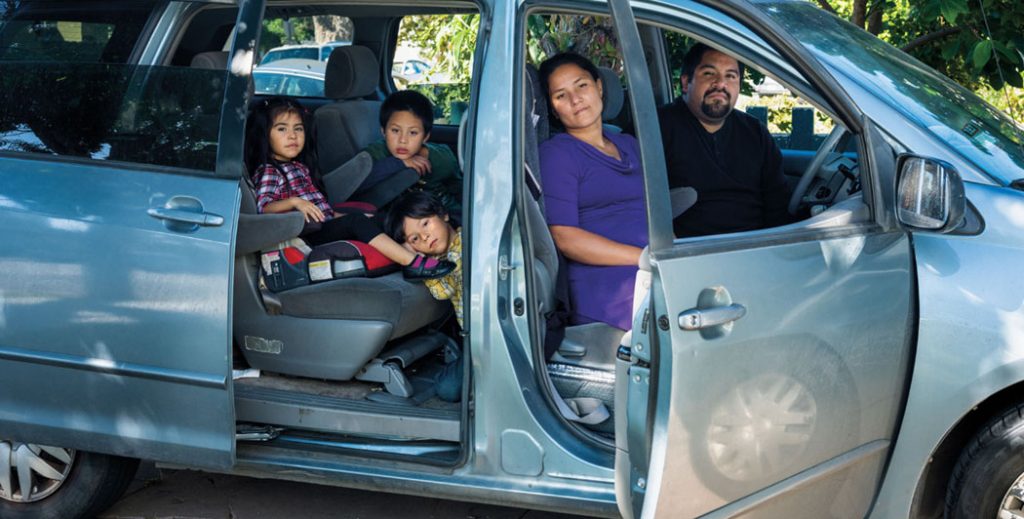
From left to right: Adelene, Frankie, Josephat, Brenda, and Candido in the 2007 Toyota Sienna that they lived in for close to a year
November 26, 2019
3 kids. 2 paychecks. No home.
South of San Francisco, in a fertile corner of California that feeds much of the country, working families are sleeping in shelters and parking lots.
By Brian Goldstone
Photographs by Alessandra Sanguinetti
Frankie’s morning started before the sun came up, as the steadily increasing volume of his parents’ phone alarm, coming from somewhere near the dashboard, jolted the 8-year-old awake. His dad, Candido, and 6-year-old brother, Josephat, had begun to stir in the cramped rear of the minivan, emerging from a tangle of blankets, towels, pillows, and stuffed animals. His mom, Brenda, was in the driver’s seat, which was reclined as far back as it could go; his baby sister, Adelene, who was 3, was splayed out awkwardly on the seat beside her. As for Frankie, he was in his usual spot: nestled on the floorboard between the front seats and middle row, his skinny 4-foot frame hidden in a furry green-and-brown sleeping bag meant to look like a grizzly bear.
For almost nine months, the family had been living out of their Toyota Sienna in various fields and parking lots throughout Salinas, the industrial and economic center of Monterey County. In this part of the country, there was nothing especially dramatic or exceptional about their plight, or the circumstances that led them to be without a roof over their heads. Frankie’s parents were well aware of the worsening housing crisis that had dragged tens of thousands of Californians into a similar fate. But still, Candido said, it sometimes felt as though they were the only ones out there.
Finding a place to park the van was harder than expected. At first, the family tried the parking lot of a Food 4 Less grocery store. But the following morning, an employee warned them not to return; a neighborhood gang, he explained, controlled the area and had been threatening homeless people. He said they’d recently slashed someone’s tires. The family drove to a nearby strawberry farm, which proved more hospitable. In exchange for doing chores around the property, such as cleaning the bathrooms and emptying the trash, the farm’s owner would fill up their gas tank. But eventually other families, in their own cars and SUVs, began showing up, and it became too much. They’d have to go somewhere else, the owner said.
Now they were in the parking lot of Natividad Medical Center, just outside the emergency room. The lot was well lit, and there were bathrooms in the ER waiting room, open 24 hours. The hospital staff was mostly welcoming. At night, however, after everyone fell asleep, Candido had been noticing the tiny flicker of a lighter in a nearby pickup truck and the profile of an older man. Candido kept the van’s dome light on and made sure its doors were locked.
As parents, Candido and Brenda believed the most important thing was to project confidence; their kids needed to see that they had a plan. The couple tried to avoid worrying about how long they’d be in the van, or where they might go next, but it was impossible to think about anything else. There were bouts of cursing and storming off and feeling that one more minute in the vehicle, packed with the entirety of their possessions, would drive them all insane. There were weekend excursions to Target for little toys and treats, bought with money they couldn’t spare. When temperatures dropped, it was a terrible calculus: bundle up as best they could, the kids shivering and complaining, or run the van’s heat all night and use up precious gas. Or, if there were any rooms available, they could spend up to a couple hundred dollars a night at the Best 5 Motel or Good Nite Inn?—?making it that much less likely that they’d save enough to get out of the van entirely.
Mornings were the hardest. Everyone was achy, tired from a bad night’s sleep, and on this morning, too, it was all they could do to keep to their routine. Brenda and Candido insisted on maintaining a semblance of order. “We’re not like some people,” Candido would tell the kids. “We wash our clothes. We don’t pee outside. We keep ourselves clean.” In the hospital bathroom, while Candido got ready to go to work and Brenda stayed behind with Adelene, Frankie helped wash and dress Josephat, brushing his brother’s teeth, then his own. Breakfast was whatever Pop-Tarts or granola bars were left over from the food bank. Finally, they straightened up the van, pulled the seats back into position, and put on their seat belts, Adelene in her car seat, Frankie and Josephat in their boosters. They drove the 15 or so minutes into town, fusing with the early traffic, indistinguishable from all the other families starting their day.
When the van stopped, the boys hopped out. They went around to the trunk, grabbed their backpacks off the built-in clothing hooks, hugged their parents, and walked through the front gate of their elementary school.

For more information please visit the following link:
https://story.californiasunday.com/homeless-families?utm_source=pocket-newtab
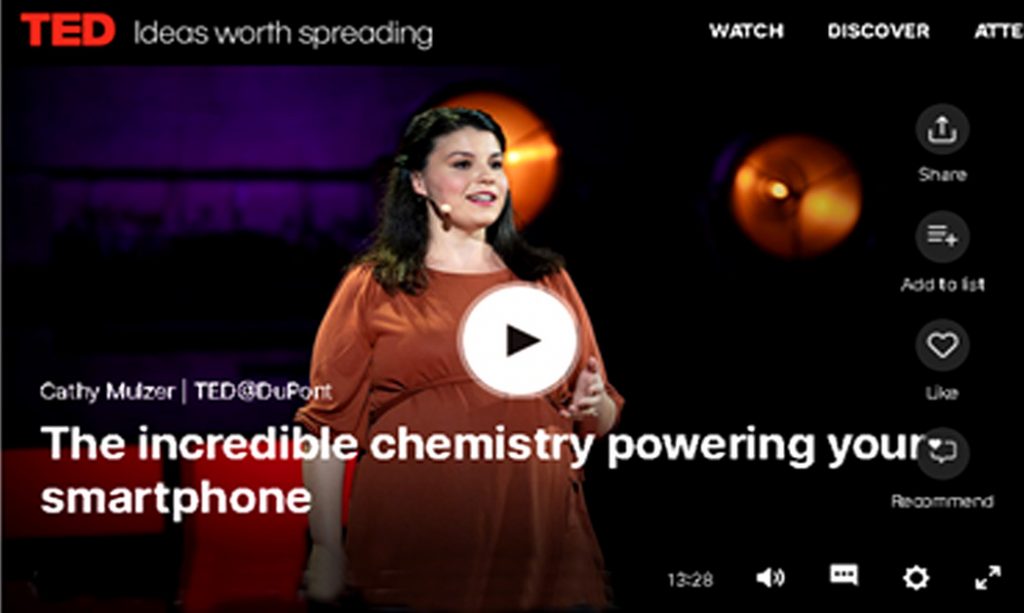


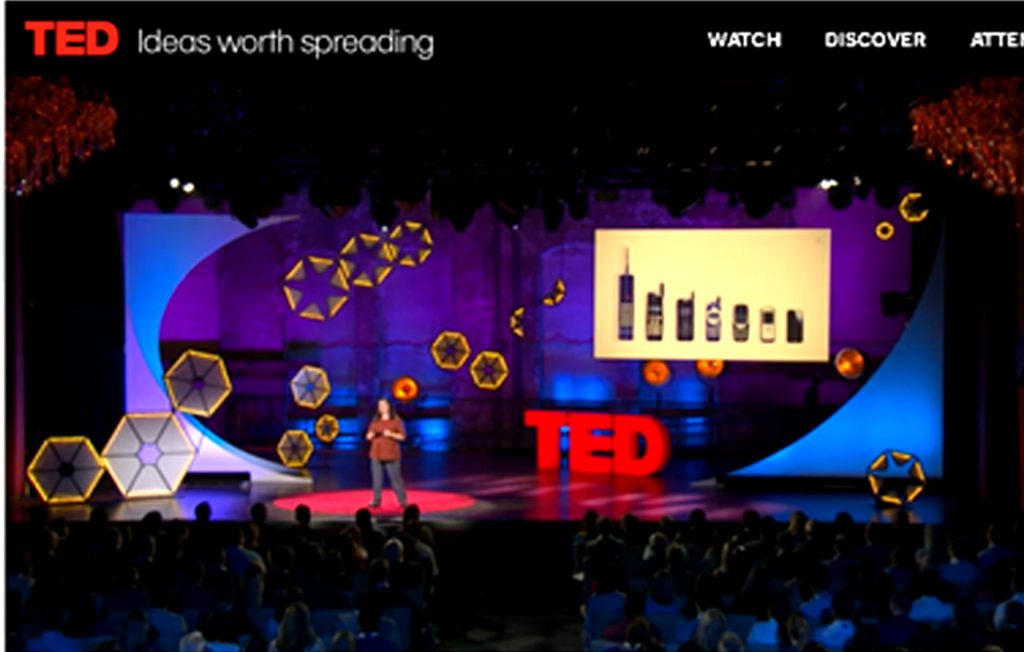
TED Talks: Cathy Mulzer – The incredible chemistry powering your smart phone
Ever wondered how your smartphone works? Take a journey down to the atomic level with scientist Cathy Mulzer, who reveals how almost every component of our high-powered devices exists thanks to chemists — and not the Silicon Valley entrepreneurs that come to most people’s minds. As she puts it: “Chemistry is the hero of electronic communications.”
This talk was presented at a TED Institute event given in partnership with DuPont. TED editors featured it among our selections on the home page. Read more about the TED Institute.
About the speaker
About TED Institute
Every year, TED works with a group of select companies and foundations to identify internal ideators, inventors, connectors, and creators. Drawing on the same rigorous regimen that has prepared speakers for the TED main stage, TED Institute works closely with each partner, overseeing curation and providing intensive one-on-one talk development to sharpen and fine tune ideas. The culmination is an event produced, recorded, and hosted by TED, generating a growing library of valuable TED Talks that can spur innovation and transform organizations.
Learn more about TED Institute
TED@DuPont | September 2019
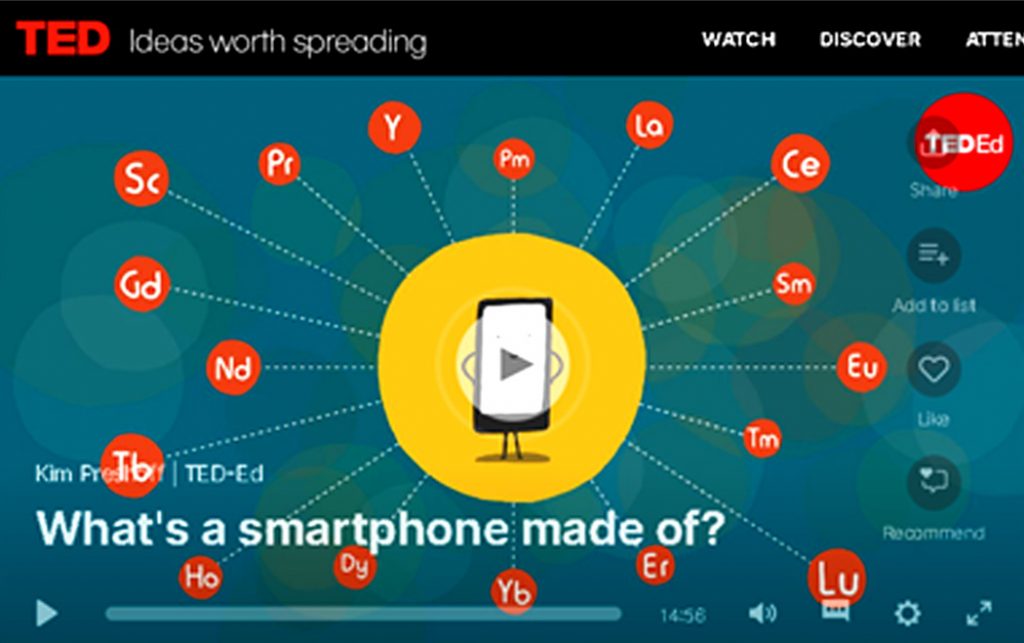
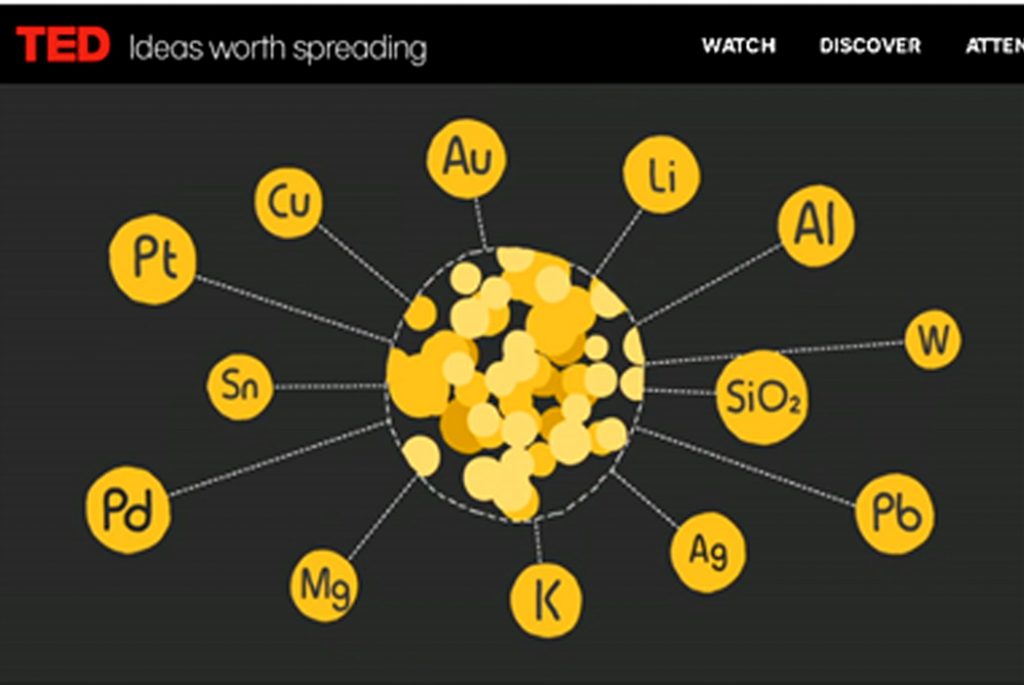
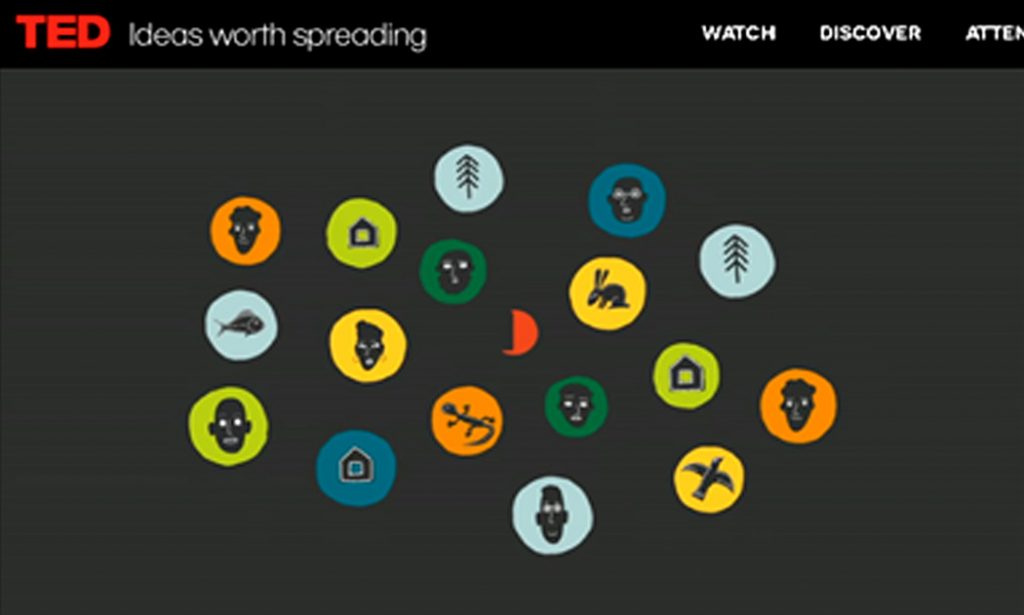

TED Talks: Kim Preshoff – What’s a smartphone madeof#t-286167
As of 2018, there are around 2.5 billion smartphone users in the world. If we broke open all the newest phones and split them into their component parts, that would produce around 85,000 kg of gold, 875,000 of silver, and 40,000,000 of copper. How did this precious cache get into our phones–and can we reclaim it? Kim Preshoff investigates the sustainability of phone production. [TED-Ed Animation by Compote Collective].
Meet the educator
Kim Preshoff · Educator
About TED-Ed
TED-Ed Original lessons feature the words and ideas of educators brought to life by professional animators.
500 + Fish Identification Documentary by Pano4life
Oct 29, 2017 Lily R.
A few years ago I was stung by the “Diving” virus. I quickly became an instructor and over time I was able to accumulate more than 6000 dives mainly in Thailand, Indonesia, Philippines and Malaysia. During these dives, I noticed how fragile the ecosystems are. I came up with the idea of ??filming everything I could for fear of not seeing it again one day. Of course, I could not take my camera for each of these dives but I do it whenever I have the opportunity. Today we were able to identify and filmed in full HD 500 different underwater species. This documentary of 60 minutes retraces these different species with the scientific description and the Latin name of each species. Our goal is to show the world how precious the oceans are and full of life that unfortunately the humanity is likely to endanger … We sometimes forget that the oceans provide us with more than 60% of the oxygen we we need to live. Half of the photosynthesis and removal of carbon dioxide takes place in the oceans. Marine species play a key role in this regulation. It is therefore important to identify and protect them. Unfortunately for humans, this protection is not a priority. On the contrary, the human pressures on the oceans are increasing every day, the impact is irreversible! Through this documentary, we hope to be able to arouse interest on the various underwater species and their protection. We also say to ourself that if our future generations also want to be able to contemplate the beauty of our planet, we have to act quickly! If we continue like this, our grandchildren will not even see a quarter of what you see in this documentary. I would especially like to thank my partner and dive Buddy Lily Romero who filmed and helped me editing this amazing video. As well as laurent Minsart for some macro shots in Lembeh, Indonesia. Special Big Up to all those who participated by loan or by far at this documentary, Dive Guide Local Boat Captain. More Info or collab Lily Romero & Pierre Bijloos www.lilyromero.com IG: LILYRYOGA IG: PANO4LIFE
Category Travel & Events
A Post By: Gavin Hardcastle

The most common question I get asked by my workshop students is ‘how do you get such sharp images?’. It’s actually really simple. Basically, avoid movement of any kind while the shutter is open, focus well and choose the right aperture for your creative vision. Mostly it’s just plain old common sense with a couple of technical elements thrown in, so if you want to learn how to get super sharp landscape photography images, here’s my list of top tips.
Top tips for sharper landscape photography
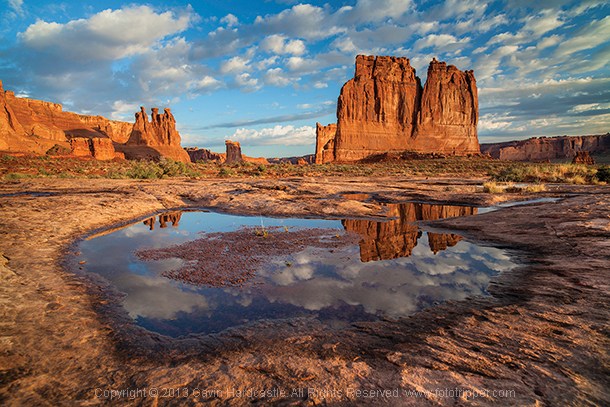
1 – Use a good tripod with a sturdy ball head and make sure everything is TIGHT
Seems obvious, but time and time again I see students using decent tripods and they often don’t have everything clamped down tightly. For example, the attachment that is screwed to the underside of your camera should be as tight as you can get it, eventually it’ll work its way loose. Make sure that ball head is completely locked down once you’ve composed your shot.
2 – While taking the shot, don’t place your hands on your tripod
The vibrations of your hands will blur the shot. When that shutter opens, your hands should be nowhere near the camera.

3 – Use the 2 second timer or a remote shutter release
This insures that the shutter won’t open until you are completely hands free.
4 – Cheap lenses will defocus while you rotate your circular polarizer
This is another one that seems obvious but I’ve seen it happen a lot. Let’s say you’ve achieved perfect focus on your landscape composition and now you’d like to rotate the polarizer which is attached to your perfectly focused lens. Guess what, as you rotate that filter, the lens is now losing its focus because of the movement and pressure you’re exerting on the filter. This rarely happens with high end lenses but I’ve seen it happen a lot with cheaper kit lenses that are poorly engineered. When this happens simply remember to refocus before hitting the shutter.
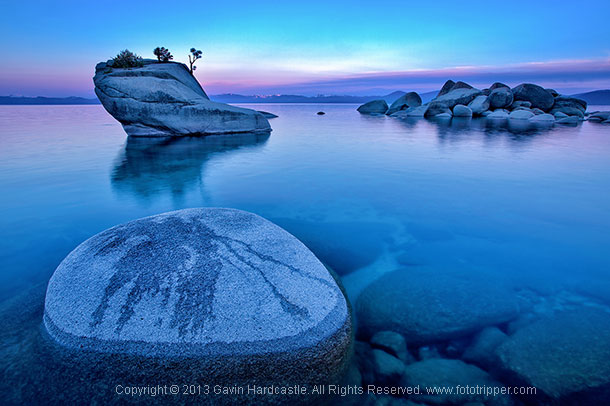
5 – Enable the mirror lock-up if you have a DLSR
Using mirror lock-up ensures that the mechanical shock induced by the cameras mirror mechanism has dissipated by the time the shutter opens.
6 – Remove your camera strap
In windy situations it will act like a sail and induce vibration.
7 – Add some weight to your tripod’s central column
If the conditions are windy, it will also help reduce vibration.
8 – Place a small but heavy bean bag on your camera and lens
Do this just before taking the shot to further eliminate movement from shutter shock.
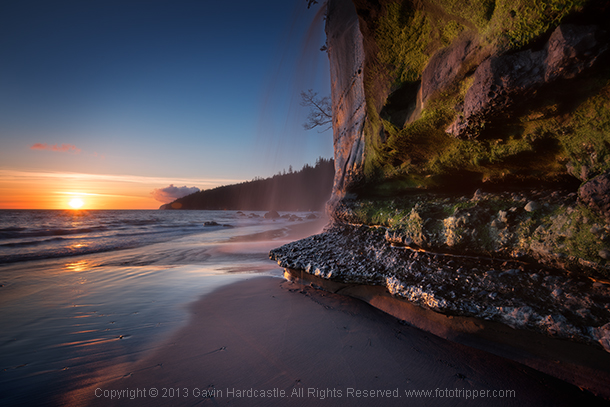
9 – Choose a Mid-range to Narrow Aperture
This one should be an article in itself but for now it’s important to understand that if you want corner to corner focus in your landscape images you’ll need to select an aperture that gives you a wide depth of field. Using f/2.8 is pointless, so pick an aperture like f/11 or f/16 depending on how close you are to your foreground subjects. Be aware however that the narrower the aperture (larger number like f/22) the less sharp your image will be due to light diffraction so experiment with your lenses to discover their sweet spot for wide depth of field.
Side Note: Shallow depth of field in landscapes can be beautiful when done well, in which case you’ll need a wide aperture like f/2.8 and ideally a lens that delivers beautiful bokeh – most super wide angle lenses don’t do bokeh well.
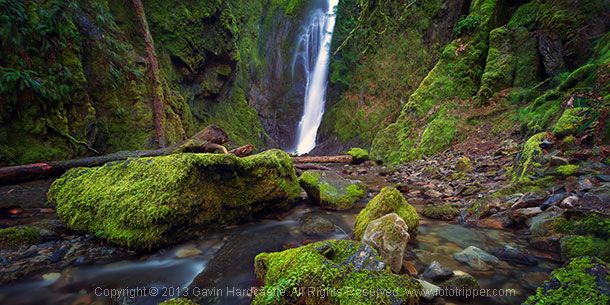
10 – Focus In the Distance
Don’t focus on the object closest to you. Pick an object in the middle distance that has a clear contrasting line and focus on that. You could focus to infinity but beware that most of the wide angle lenses I’ve used actually focus beyond infinity so I often have to focus to infinity and then carefully rotate the focus wheel back so that it’s just slightly before the ‘infinity’ mark.
11 – Put Your Glasses On
If you need glasses in order to see clearly and focus on things, it should go without saying that you might need to put on your stylish and expensive bifocals in order to achieve clear focus in your photography. Besides, everyone knows that glasses make you look cool and more intelligent, so why not put them on?
12 – Use Live View or EVF magnification
If you have a DLSR with an optical viewfinder I highly recommend that you use your cameras ‘Live View’ mode and then magnify it to your point of interest and use your manual focus ring to achieve sharp focus If your camera has an EVF (Electronic View Finder) you can do the same thing while looking in the EVF. I actually prefer this because you don’t get distracted by glare on the LCD or external light sources. Either way, remember to disable auto focus if you decide to focus manually with Live View.
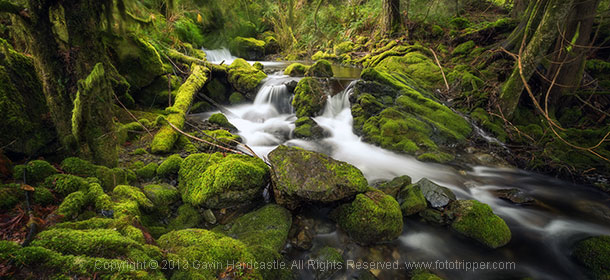
I use every single one of these techniques in my Vancouver Island photo workshops and I teach them to all of my students. If you follow these tips every time you shoot landscapes, you’ll be sure to get much sharper images. If you’ve got some of your own tricks and tips for getting super sharp landscape images please leave a comment below and share your knowledge.
PS: Want to learn more about Landscape Photography? Check out our brand new eBook launched today – Loving Landscapes: A Guide to Landscape Photography Workflow and Post Processing.
Read more from our Tips & Tutorials category

Gavin Hardcastle is a fine art photographer, writer and instructor from BC, Canada. Become a better photographer today with his free photography guides and photography tutorials. You can learn from Gavin directly at his global photography workshops in some of the worlds most spectacular locations. Upgrade your post processing skills with his online video tutorials for Photoshop and Lightroom.
If you enjoyed this article, you might also like…
Featured in Tips & Tutorials
Weekly Photography Challenge – Reading
November 13, 2019 Laura Staugaitis
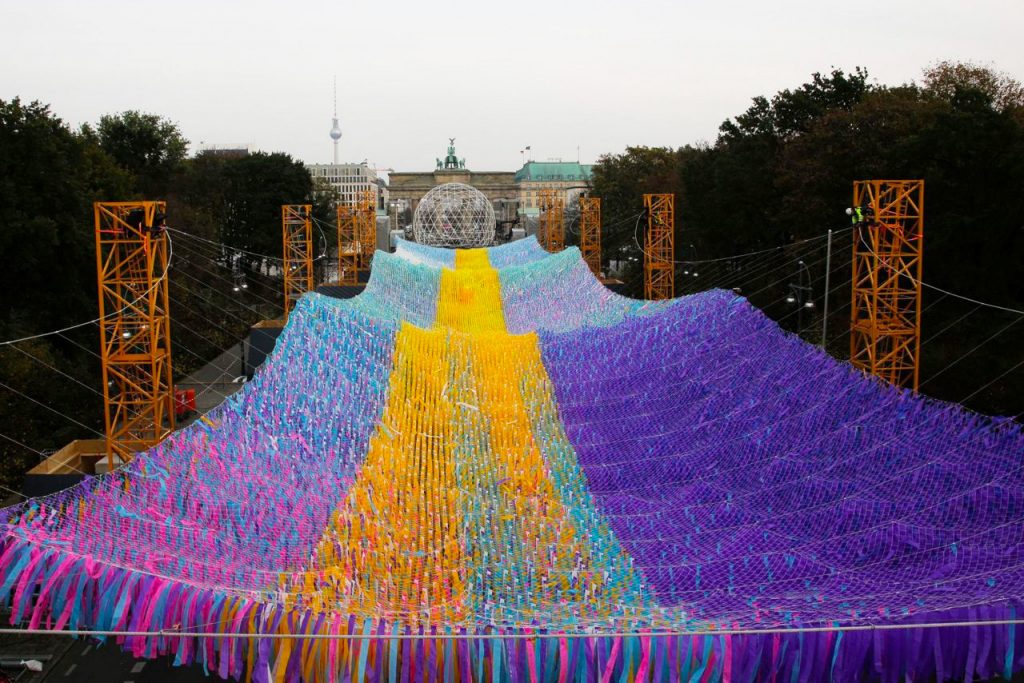
On November 9, 1989, German officials decided to allow residents of Communist East Germany to cross over and visit the Western, democratic half of the divided country. Though the complex process of physically and ideologically reunifying the country took about a year in total, November 9th is considered a landmark day. To celebrate 30 years since the Berlin Wall began to break down, artist Patrick Shearn (previously) was commissioned to create a large-scale installation that integrated the reflections and hopes of 30,000 people.
Visions in Motion was on view November 4th through 10th in front of Berlin’s Brandenburg Gate, a location that had previously been a demarcation of division. A statement from Poetic Kinetics explained, “the artwork’s rectangular shape conjures the form of the wall; but instead of a heavy, impenetrable border, the form takes flight.” The massive installation spanned 20,000 square feet and was comprised of 120,000 fabric streamers, a quarter of which featured hand-written messages that were collected in the months leading up to the display.
Shearn is a resident of Los Angeles, Berlin’s sister city, and is renowned for his large-scale kinetic installations, which he calls “Skynets”. Tying the German installation to its sister city, the Los Angeles-area Wende Museum, which houses Cold War artifacts, invited Los Angelenos to contribute messages to Visions in Motion as well.
Shearn and his team at Poetic Kinetics are prolific creators. You can explore much more of their archive on the Poetic Kinetics website, and follow them on Instagram to keep up with their latest projects around the world.
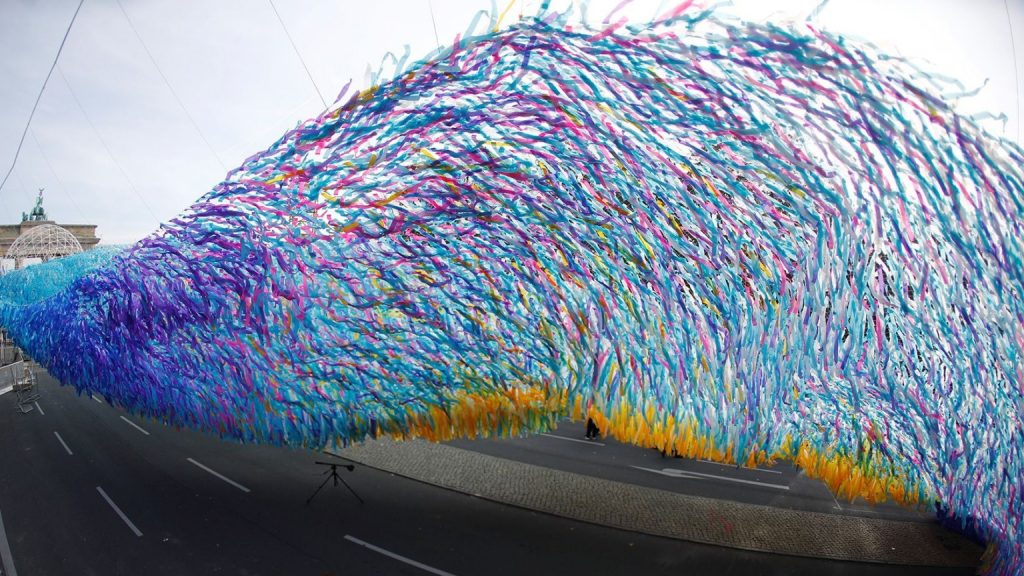
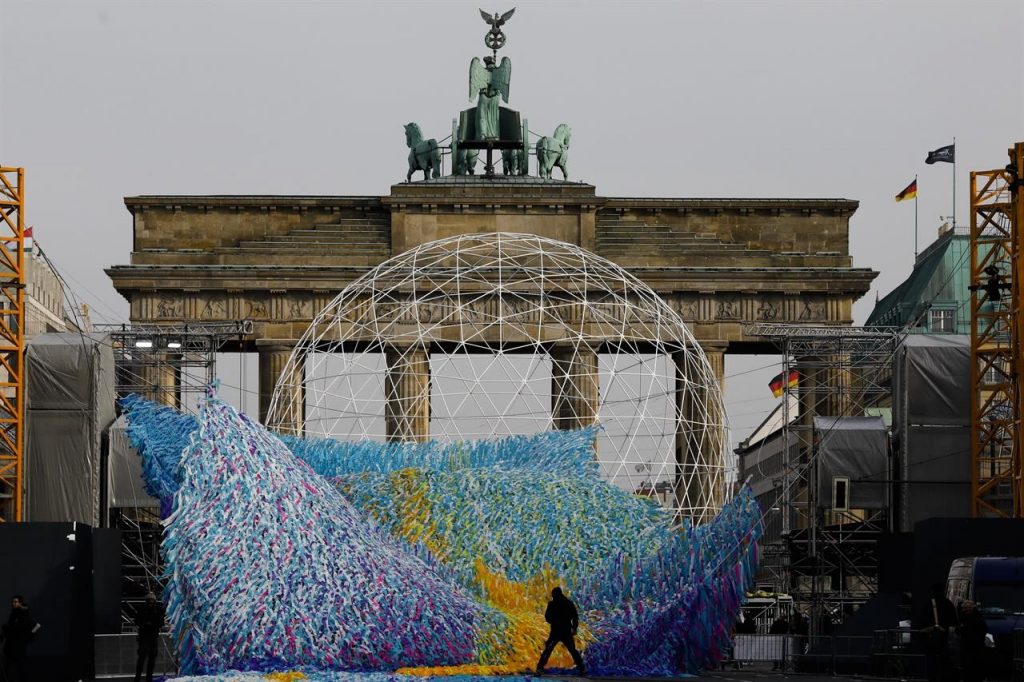
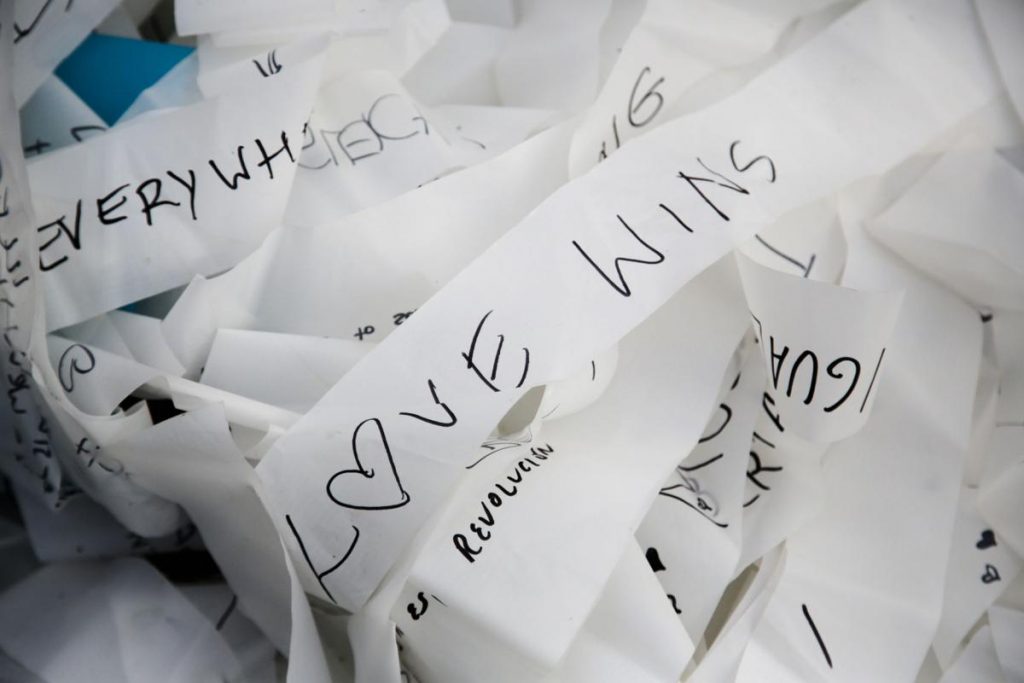

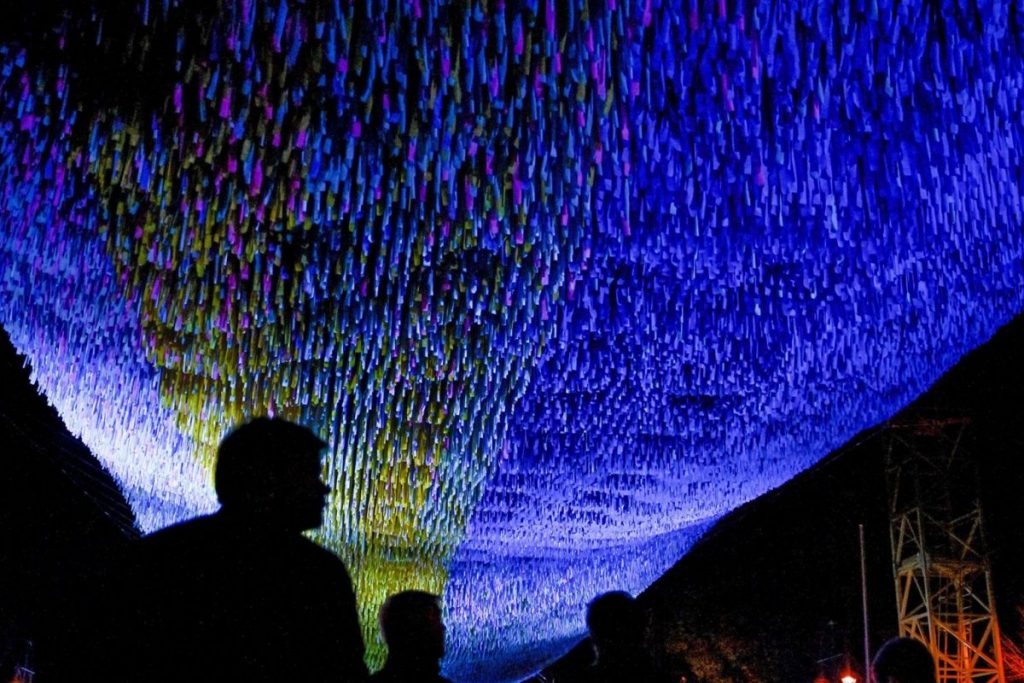

Finished “Peace” artwork 9
Shadow of Peace and La Asociación de Barranquiteños de NJ Inc., Puerto Rican Festival in Newark on August 11, 2012, organized by Carlos Maldonado Pastrana, President of La Asociación de Barranquiteños de NJ. Finished artwork, after the written comments by Ing-On Vibulbhan-Watts
Link to 6th Annual Art and Music Fair Elwood Park Page:
Leave a Reply